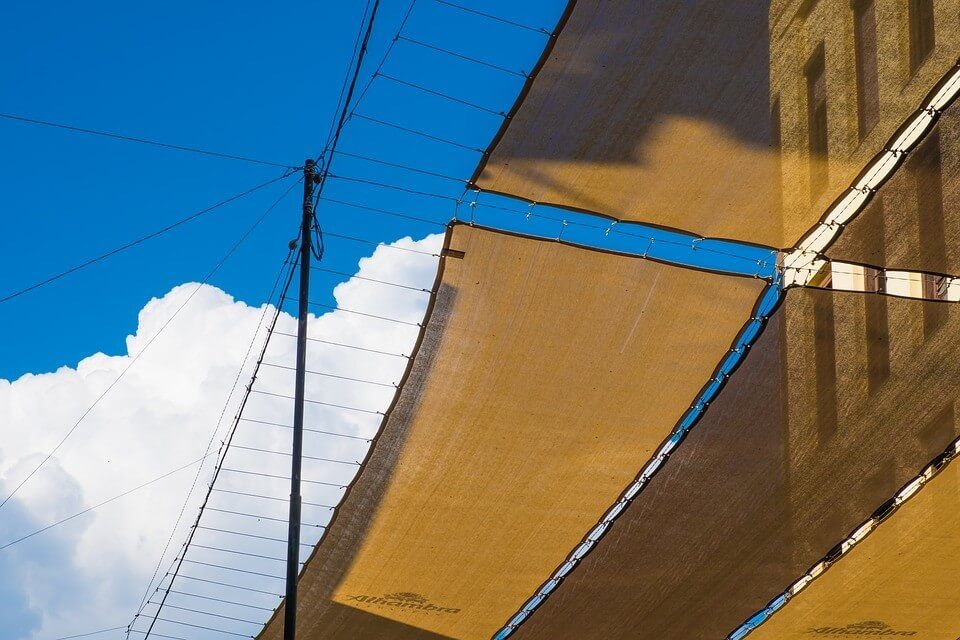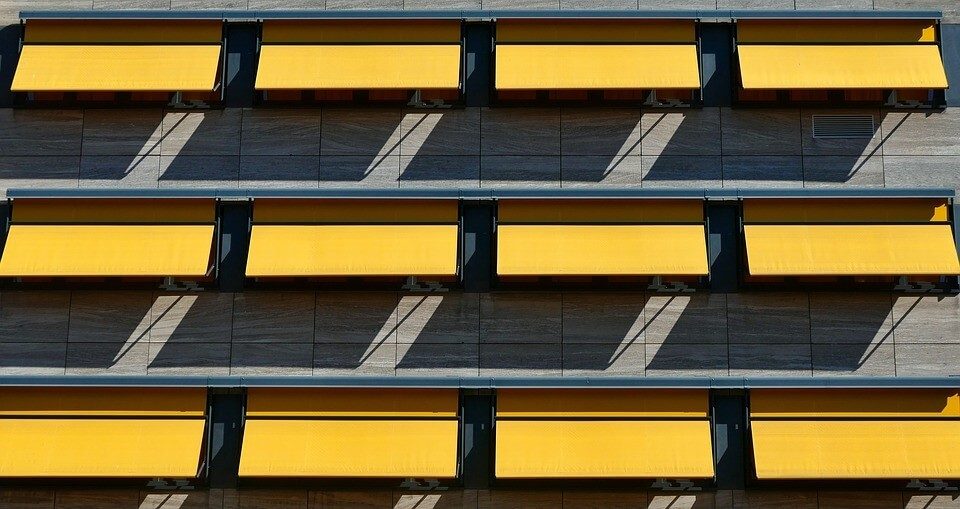For many years, people have used awnings to spruce up curb appeal and add value to their property. Through the years, awning materials and installation methods have changed and developed. With so many options, it’s important to consider several factors when purchasing a new awning. Depending on your geographical location and desired level of maintenance, certain fabric types will work better than others. It is imperative that you research your options to make an informed decision. If you are planning to buy an awning for your property, read our awning fabric guide and find out what you should consider when choosing your awning fabric.

Awning Fabric Selection
Choosing an Awning Material
When people decide to purchase an awning, they must decide which type of material to use. Rather than focusing strictly on the price, you should take time to look at the specifics of each awning so you can make the best decision for your space, and the quality should always be the main consideration. Our awning fabric guide will help you find the best option for you!
Cotton Canvas
Cotton canvas awnings are a classic option for buyers. Once very popular, they have become scarcer in recent decades because of longer-lasting alternative fabrics. Awnings made from cotton are recommended by environmentalists because of its eco-friendly characteristics. However, one of the drawbacks of cotton canvas awnings is rot, mildew and fade caused by weather. They can be ripped by strong winds and large amounts of rainfall, but to protect the awning, users can retract the awning when potential bad weather occurs.
Acrylic Coated Polyester
Using an acrylic-coated polyester material is beneficial because they are stretch resistant. They are ideal for geographical areas with heavy rainfall, and most are weatherproof. Another benefit of using acrylic-coated polyester material is that the fabric does not leak but can fade easily.
100% Acrylic Fabric
This type is what is most commonly used in North American and Europe today. The acrylic solution (liquid) has the color added then fibers are created, then yarn is woven. Unlike the other fabrics, a fiber of acrylic is like a carrot, the same color all the way through. This fabric will not rot, mildew or fade and is guaranteed for 10 years.
Vinyl Laminated Polyester
Vinyl laminated polyester awnings are immune to mildew and other elements that are found in humid areas which make them the ideal choice for areas with high humidity. It can also decrease the number of UV rays that are trying to penetrate inside the structure. The UV light is responsible for furniture fading and using vinyl laminated polyester will help protect the home’s interior.
Woven Polyester Material coated with PVC
Awnings that are made from woven polyester material and later coated with PVC are also ideal for areas with high humidity. Using this type of material will produce a durable awning which can withstand extreme natural forces. The woven polyester material that is coated with PVC is waterproof which increases the product lifespan, and this type of material can be easily cleaned.

Awning Fabric Selection
Factors to Consider
There are many factors that go into choosing the best material for your circumstances. These include durability, fading, water repellency, stretch resistance and UV protection. Accurately determining your primary concerns can be the deciding factor in ensuring your awning will last for decades. When purchasing, you should consider your geographical area, how and where the awning will be used, and the level of care. All of these will impact the decision of which awning you should purchase. Our awning fabric guide goes over these facets, allowing you to find the best choice for your space!
Cleanable Fabrics
Some awning fabrics are machine washable which will provide the owner with an option to quickly wash it, and other fabrics can be cleaned while still attached to the awning. Fabrics such as 100% acrylic can even withstand straight bleach if needed to clean the fabric. By keeping the fabric clean, you can extend the life of your awning.
UV and Sunlight Protection
Another important consideration is the amount of UV protection the awning provides. Research shows that radiation from the sun damages multiple areas of the body. It can also cause skin cancer under consistent exposure. Awnings are used to protect an area or a property from the harsh sunlight as well as UV rays. Consider an awning that fully prevents UV rays from entering the body, as well as the interior of a property. These awnings will keep the residents protected from the dangerous UV rays, while at the same time, preserving the colors of furniture pieces and preventing it from staining.
Water Resistance
Water resistance is also an important factor when choosing the right awning because extreme moisture can result in damage to the awning. In a tropical environment, atmospheric humidity would cause excessive moisture that can damage awnings that are not water-resistant. A water-resistant awning will resolve this, and they come in various designs allowing you to maintain your home’s design.
Adjustability
The adjustability of the awning should be a key consideration. Imagine setting up an awning for your property, and the product you purchased it not adjustable. This would limit where you can place the awning and how it can be used. There are many adjustable awnings that you can purchase online, and you can also ask the in-store experts about their recommendation.
Durability
The durability of an awning depends on the materials used to create it. When choosing an awning, research the best materials that will last the longest. You can also consult the experts about this matter because they can recommend a brand that is known for manufacturing durable awnings. Based on the experiences of those who have purchased durable awnings in the past, the best material is coated polyesters because it can protect the awnings from different elements.
Weather
The weather is a major factor to consider when purchasing an awning. In places where the weather is constantly rainy, humid, or wet, the awnings that are required are those that offer protection against water and moisture. Awnings in these areas tend to wear easily because of this type of weather. In places where the wind is strong, consider purchasing a durable awning that can survive strong blows of wind. If the awning is not strong enough, it can be ripped apart by the strong winds.
Geographical Climate
The geographical climate should also be considered when buying an awning. The world is divided into many geographical climates, and you need to find what type your location falls under. Cold areas and hot areas require different factors for the awnings. The same thing applies to humid and dry areas. If you are unsure about the perfect awning for your geographical location, try to ask the experts about their opinion, or look for reliable customer reviews that can help you decide.\
Maintenance
Awnings require regular maintenance, and you should set aside a part of your seasonal or annual budget to clean the awnings. You can send it to a professional cleaning service or clean it yourself as prescribed by the manufacturer. You should also check for holes to prevent water from damaging the foundations where it is attached. When you notice holes on the awnings or when the seams start to decay, you should consider buying a new one. After purchasing an awning, you should research the proper care techniques of the specific structure and material used so you can ensure your awning will not be damaged in the process.
Warranty
The type of warranty is an important factor to consider when buying awnings. Depending on the manufacturer, a warranty will either replace a damaged awning or provide repair work. Before making any purchases involving a warranty, you should read it in its entirety so you know the terms and conditions. You should look at what the warranty covers, the type of work it provides, and how long it lasts. It is important to keep a copy of the warranty and your purchase receipt in case your awning fabric ever needs to be replaced or repaired under warranty.
Conclusion
Awnings have been around for so many years, decorating our lively cities with colorful textiles that also serve as protection from the sun. If you want to install an awning on your property, you need to consider the materials used and several other factors that will give you a satisfactory result. You also need to research to give you an idea of how you should set up an awning for your home to make it cooler and more comfortable for everyone. Take the time to look at our awning fabric guide and choose the perfect options for your space to have the best end result.

